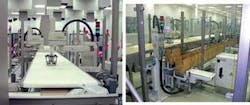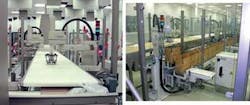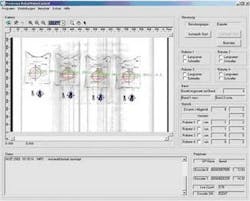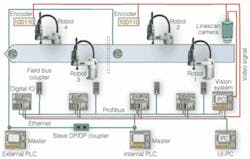Vision-guided robots speed medical-device packaging
Integrated off-the-shelf components, software, and robots inspect and place plastic medical infusion bags in final packaging.
By R. Winn Hardin, Contributing Editor
The demand for plastic infusion bags, used for blood storage, intravenous-solution dispensing, and drug-product packaging, is increasing. As a result, manufacturer Fresenius Kabi Deutschland (FKD) concluded that automation was the best way to increase both throughput and packaging quality for its customers. The company turned to robot-and-vision supplier Adept Technology and Adept-system-integrator Erhardt + Abt Automatisierungstechnik for a solution, which included Adept Cobra 800 series robots for pick-and-place applications and a vision-guided component with Adept’s HexSight vision platform for robot guidance.
Distributed workcells
The FKD infusion-bag packaging line is composed of two conveyors set end-to-end to form one long production line, according to Axel Kretschmann, FKD lead project engineer. Bags travel down the line at 10 m/min, and the large number of bags processed requires four Cobra 800 robots to achieve cycle times of less than 2 s, sufficient to capture every bag coming down the line (see Fig. 1).
tion-system integrator Jürgen Bosch, designers chose a Hommelwerke Uniline 2048 linescan camera because it can receive signals directly from the two encoders, which provide the basis for tracking product on the conveyor. Also, when bundled with a Hommelwerk Horizon 4LC frame grabber, the combined imaging system has an adjustable integration time, an on-board watch-dog function for identifying errors in the vision chain, and high sensitivity.
Fluorescent lighting illuminates the bags as they enter the packaging line, and images are acquired by the linescan camera. Illuminators are located below the clear conveyor and backlight the clear infusion bags to highlight the solid plastic connectors and label on the bags.
As the images are collected, the analog signals are converted to digital values through the Horizon 4LC frame grabber and then passed into the PC host’s 512 Mbytes of RAM. The vision system PC host runs on a 1260-MHz Pentium III microprocessor with 133-MHz bus. The PC from B&R Industrie-Electronik also has room for four PCI cards and has a 20-Gbyte hard drive. A separate PC with the same specifications acts as the user interface for the vision portion of the system. The vision-system PC host acts as a slave to the Siemens S7 300 PLC inside the Adept robot workcell.
Written in C++, Adept’s HexSight image-processing library on the PC host assimilates each line into a continuous digital image. The software normalizes the illumination using HexSight’s HSImageHistogram function. HexSight’s Locator function uses a geometric search algorithm to find the two plastic connectors that will support the infusion bag during use and a blob analysis algorithm to find the connector on the “right side.” Using the right connector as a fiducial, HexSight then locates the label information, and optical-character-recognition algorithms verify the correct information based on product descriptions received by the S7 300 PLC from the upstream manufacturing line (see Fig. 2).
Inspection is location
Connector and label location data allow HexSight to determine the rotation and skew of the infusion bags, which come across the conveyor both right side up and flat on the conveyor. A pair of 5000-count-per-round Pepperl + Fuches DG 60 LES 01 encoders-one on each conveyor-provide counter data to the camera and the S7 300 internal PLC, as well as the vision system’s PC host through an ADDI-DATA APCI-1710 multifunction, multichannel board across a standard LVDS cable.
The encoder signals allow the vision systems, material-handling PLCs, and robot workcell to synchronize during inspection and pickup of the infusion bags. Frequency counters attached to the conveyors’ drive motors create a closed-loop-feedback system for the external S7 300 to control the exact speed of both conveyors, maintaining 10 m/min. This is particularly critical for later pick-and-place operations (see Fig. 3).
According to Jan-Philippe de Broeck, Adept Canada vision system product manager, part of the integration challenge was writing new software for the hardware added to the line. “Erhardt + Abt had to write wrapper classes for the counter card, frame grabber, and Profibus card,” he says.
The location from the encoder and orientation information from the vision system are passed from the vision system PC host across the Profibus real-time network to the S7 300 PLC to reduce latency; this PLC then passes the data to the Adept robot controllers.
“If a robot requests a part via digital signals over Profibus, the vision application searches its parts queue for a pickable part for that robot. The calculated coordinates of the part are also transferred via Profibus,” Erhardt + Abt’s Bosch explains.
The vision system and Adept robot controllers convert the image-location data into robot movements. The vision system also contains a load-balancing program to ensure that each robot keeps a consistent cycle time and that 100% of the bags are collected by the end of the conveyor-with the exception of bags that do not meet the label and inspection criteria set by FKD during initial system setup. An Ethernet connection permits the operator to access and alter both vision and robot-control programs through the user-interface PC.
Features, advantages, benefits
Fresenius Kabi Deutschland (FKD) sought to improve throughput and packaging quality of plastic infusion bags by using system-integrator Erhardt + Abt Automatisierungstechnik to integrate robots and vision systems from Adept Technology. “We tested robots from different manufacturers. The features of the Adept devices-durability, speed, and conveyor tracking, as well as the vision system-have convinced us that we made the right decision,” comments Axel Kretschmann, FKD lead project engineer.
Company Info
ADDI-DATA,
Ottersweier, Germany
www.addi-data.com
Adept Technology,
Livermore, CA, USA
www.adept.com
B&R Industrie-Elektronik,
Bad Homburg, Germany
www.br-automation.com
Erhardt + Abt Automatisierungstechnik,
Kuchen, Germany
www.erhardt-abt.de
Fresenius Kabi Deutschland,
Friedberg, Germany
www.fresenius-kabi.com
Hommelwerke,
Konstanz, Germany
www.opti-sens.de
i2S Land Of Vision,
Pessac, France
www.i2s-linescan.com
Pepperl + Fuchs,
Mannheim, Germany
www.pepperl-fuchs.com
Siemens,
Nürnberg, Germany
www.automation.siemens.com




